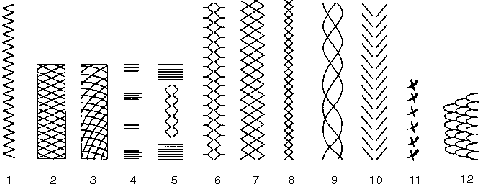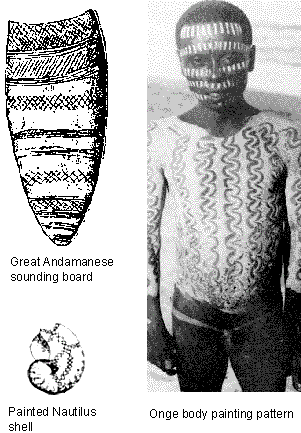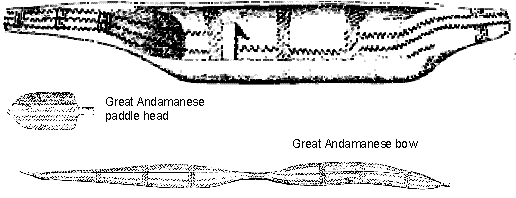Artistic expression, it is claimed, is almost as fundamental to humanity as language. This may be so, but among traditional Andamanese decorative art is found only in a number of remarkably restricted forms - the most restricted of all known human groups.
It is not that the Andamanese lack a sense of beauty. There is a deep sense of elegance and beauty way beyond that required by mere utility in the way traditional canoes, paddles, baskets and some types of bows and pots were decorated. Much of the women's basketry work is not only elegant in form but very beautiful with their interweaved brown, black and yellow strands of fibre. Some types of bows made by the men also highly elegant.
The Andamanese are in no way deficient in the ability to visualize things. As one early observer noted:
... the intelligence they display in recognising any familiar form depicted in a sketch; and while no such method for indicating the situation of any place is known or employed among themselves, some of them are quick in understanding a chart of their own country, and are able to point out the sites of their various encampments
This is not the place to discuss the eternal question "what is art." Whatever it is, among Andamanese it is represented by a limited number of standardized abstract pattern. Each of the pattern had its own name. There is no figurative art at all, no recognizable outline of the human form, of animals or even of objects. The patterns may once have originated in figurative representation but if so, that development would have been a very ancient one. The pattern are of very considerable age and do not represent a recent "degeneration." They are similar among all Andamanese groups which fact would seem to speak for a common ancestry, before the various groups split up and lost touch with each other. More concrete is the archaeological evidence of decorations that have survived on shards of pottery - some more than 2000 years old - that are strikingly similar to the standard patterns known from a variety of recent objects and from Andamanese body painting.

1. jobo-tartanga or chevron (painted with ochre and white clay, on canoes, paddles, buckets, etc)
2. ig-yitinga or cross lines (painted with white clay, on sounding boards; cut with a sea shell, on waist belts and other items of decorative clothing)
3. ig-barnga or cross lines (two colors, vertical lines painted in ochre and the oblique lines in white clay, on baskets)
4. ig-oinga or parallel lines (painted with ochre or white clay across the handle of paddles)
5. jobo tartanga or mixed lines (painted with white clay, on belts and head dresses)
6. to-nanga or zig-zag lines (painted with white clay, on belts and head dresses)
7. ige-unga (painted with brown or white clay, on belts and head dresses, nautilus shells used as drinking vessels and wooden trays used for meals)
8. jobo-tartanga or lozenge lines (painted with brown or white clay, on belts and head dresses, nautilus shells used as drinking vessels and wooden trays used for meals)
9. polior-nga or plait lines (painted with white clay on bows and eating trays)
10. bamga or fish bone lines (painted in various colors on the sling used to carry infants)
11. ige-unga, ig-yitinga or cross incisions (cut with sea shell on bows and the handles of adzes)
12. otenga or loop pattern (painted with white clay on seashells used as food trays)


